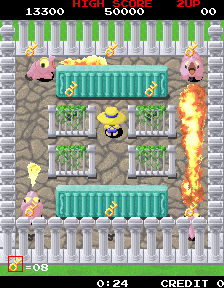 Namco's Museum series for the PlayStation met an untimely end in the U.S. when Namco Museum Volume 5 was released. Ever since NM3, it seemed that the public was losing interest in the series, namely due to the two things - seemingly only hardcore arcade addicts recognized some of the more obscure titles that the casual gamers had never seen before, and that all of Namco's stalwart titles (read: recognizable to anybody, not just gamers) had appeared on NM1 and NM3 - namely Pac-Man, Ms. Pac-Man, Dig Dug, Galaxian, Galaga and Pole Position. In fact, it seemed that the general opinion was that Namco should have released a disc with just those games on it, and forgot about the rest of the games that they included over the course of the series. Namco did end up listening to this line of reasoning, as future Namco Museum releases for the N64, Sega Dreamcast, PlayStation 2, Nintendo GameCube and XBox had only those titles - in the case of the PS2, GC and XBox versions, arranged versions of Pac-Man, Dig Dug and Galaga were included, along with unlockable versions of Pac-Mania and Pac-Attack.
Namco's Museum series for the PlayStation met an untimely end in the U.S. when Namco Museum Volume 5 was released. Ever since NM3, it seemed that the public was losing interest in the series, namely due to the two things - seemingly only hardcore arcade addicts recognized some of the more obscure titles that the casual gamers had never seen before, and that all of Namco's stalwart titles (read: recognizable to anybody, not just gamers) had appeared on NM1 and NM3 - namely Pac-Man, Ms. Pac-Man, Dig Dug, Galaxian, Galaga and Pole Position. In fact, it seemed that the general opinion was that Namco should have released a disc with just those games on it, and forgot about the rest of the games that they included over the course of the series. Namco did end up listening to this line of reasoning, as future Namco Museum releases for the N64, Sega Dreamcast, PlayStation 2, Nintendo GameCube and XBox had only those titles - in the case of the PS2, GC and XBox versions, arranged versions of Pac-Man, Dig Dug and Galaga were included, along with unlockable versions of Pac-Mania and Pac-Attack.
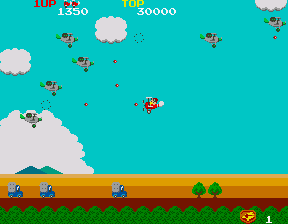 In Japan, however, Namco released one last Museum title for the PlayStation after Volume 5, appropriately titled Namco Museum Encore. NME featured seven more games pulled from the Namco arcade vaults, and for once not a single Pac-Man game was among them. The games included? The Shinobi-esque spy classic Rolling Thunder; the sequel to Dragon Spirit (which was released on NM5), Dragon Saber; the incredibly addictive puzzle game Rompers; the er, interesting Kung Fu Master wannabe Wonder Momo; the WWI-themed flying game Sky Kid; the futuristic bumper car (!) game Motos; and the embarrassing, Galaxian-esque King & Balloon. All in all, it's certainly a diverse set of titles.
In Japan, however, Namco released one last Museum title for the PlayStation after Volume 5, appropriately titled Namco Museum Encore. NME featured seven more games pulled from the Namco arcade vaults, and for once not a single Pac-Man game was among them. The games included? The Shinobi-esque spy classic Rolling Thunder; the sequel to Dragon Spirit (which was released on NM5), Dragon Saber; the incredibly addictive puzzle game Rompers; the er, interesting Kung Fu Master wannabe Wonder Momo; the WWI-themed flying game Sky Kid; the futuristic bumper car (!) game Motos; and the embarrassing, Galaxian-esque King & Balloon. All in all, it's certainly a diverse set of titles.
As is the standard for the NM series, the game opens with an FMV that showcases the games on the disc. This time, the spaceship Game Space Milaiya flies through the first five discs, transporting the stars of those discs on board, then it locates and brings aboard the stars of the six games on this disc. It's short, and is very similar to the earlier FMVs Namco came up with to open the first five volumes.
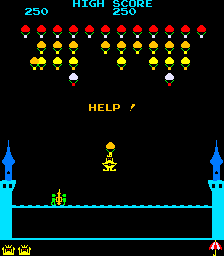 As always, the title menu gives you the option to go to the museum or to the games. Should you choose the museum option, you'll notice that there is no actual museum to explore this time around - the games are stored within the spacecraft Game Space Milaiya itself. Namco has included a lot of similar museum exhibits like the ones they included in the earlier games, but this time all of the exhibits are actually found on the games themselves. Scrolling up or down and pressing X when Pac-Man points and exclaims will let you look at them, just like in the earlier games. Also of interest is the option that lets you change the interior of the ship into one of six different backgrounds - including an arcade in the early '80s, complete with ambient sound! For the most part, the options menus are in Japanese, but it's not too hard to get through them, even if you can't read one bit of Japanese.
As always, the title menu gives you the option to go to the museum or to the games. Should you choose the museum option, you'll notice that there is no actual museum to explore this time around - the games are stored within the spacecraft Game Space Milaiya itself. Namco has included a lot of similar museum exhibits like the ones they included in the earlier games, but this time all of the exhibits are actually found on the games themselves. Scrolling up or down and pressing X when Pac-Man points and exclaims will let you look at them, just like in the earlier games. Also of interest is the option that lets you change the interior of the ship into one of six different backgrounds - including an arcade in the early '80s, complete with ambient sound! For the most part, the options menus are in Japanese, but it's not too hard to get through them, even if you can't read one bit of Japanese.
No matter what option you choose, museum or games, you're going to get to the games themselves at some point. Let's start at the bottom of the heap with King & Balloon (released in arcades in 1981). One of Namco's earliest titles, it's a shooter that's extremely similar to Galaxian - yet actually worse, believe it or not. The objective is to protect the king with a crossbow as hot air balloons swoop down and try to carry him away. Shoot all the balloons and start again. Repeat ad infinitum. Boring. I once read somewhere that Galaxian was considered to be the most boring game ever - well, K&B has it beat by a mile. The best thing about K&B are the hilarious voice samples used whenever the king is abducted.
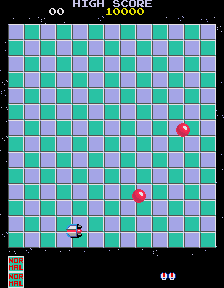 Let's move along. Next up is Motos (released in arcades in 1985). In this game you control what looks and acts like a futuristic bumper car, on a flat plain made up of tiles out in space. What you have to do is knock the enemies over the edge of the plain, while avoiding being knocked off yourself. Every so often, meteors will strike some of the tiles and knock them out, giving you more spaces to knock enemies to their dooms. Of course, this increases the possibility that you'll die as well, so it's kind of a mixed blessing. Various powerups appear as well, enabling your bumper car to jump and use special weapons, among other things.
Let's move along. Next up is Motos (released in arcades in 1985). In this game you control what looks and acts like a futuristic bumper car, on a flat plain made up of tiles out in space. What you have to do is knock the enemies over the edge of the plain, while avoiding being knocked off yourself. Every so often, meteors will strike some of the tiles and knock them out, giving you more spaces to knock enemies to their dooms. Of course, this increases the possibility that you'll die as well, so it's kind of a mixed blessing. Various powerups appear as well, enabling your bumper car to jump and use special weapons, among other things.
Sky Kid (released in arcades in 1985) is set during what looks to be World War I, except that all of the pilots in the game are birds. Your objective in each level is simple: fly from right to left, pick up a bomb, and drop it on the intended target. In your way is the enemy army... tanks, planes and ships. You can do a loop to get out of the way of enemy fire, and even if you get hit you can try to pull yourself out of your nosedive by rapidly pressing the X button. Sky Kid became a minor success (a very minor success) when Sunsoft released a version of it for the NES.
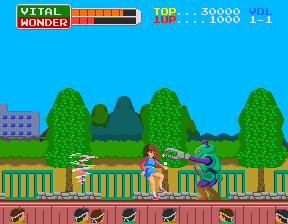 Wonder Momo (released in arcades in 1987) is an interesting variation on Irem's Kung Fu Master. You play Momo, who has to fight off an army of gray-cloaked goons and various Godzilla-esque foes. By either getting a powerup capsule or defeating enough enemies, Momo can turn into Wonder Momo, and attack the creatures with her electric hula hoop (!). There are other powerups to be had as well, and interestingly enough all of the action takes place on a stage, like the whole game is some kind of play. Momo also has the tendency to flash her panties at the world when she jumps, don't ask me why.
Wonder Momo (released in arcades in 1987) is an interesting variation on Irem's Kung Fu Master. You play Momo, who has to fight off an army of gray-cloaked goons and various Godzilla-esque foes. By either getting a powerup capsule or defeating enough enemies, Momo can turn into Wonder Momo, and attack the creatures with her electric hula hoop (!). There are other powerups to be had as well, and interestingly enough all of the action takes place on a stage, like the whole game is some kind of play. Momo also has the tendency to flash her panties at the world when she jumps, don't ask me why.
Rompers (released in arcades in 1989) is one of the most recent games Namco chose to include. It's a puzzle game unlike a lot of others that I've played. The plot is the same as a lot of them, though... your girlfriend is taken, and you have to travel through all of these different mazes to get her back. You collect keys to open the door to advance to the next level. You have no weapons, however, and the only way to defeat the creatures roaming through the mazes is to topple the walls of the maze onto the, squashing them flat. Both the monsters and the walls constantly respawn, though, so if you don't move fast enough, you'll be dead - and some monsters will return the favor and topple the walls onto you, so be careful.
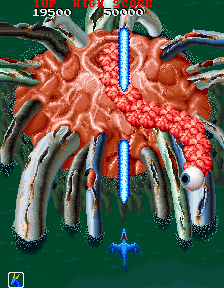 Dragon Saber (released in arcades in 1990), the "After Story Of Dragon Spirit" according to the title screen, is a truly fantastic update to the original. If you've played Dragon Spirit on any format, be it arcade, NES or Turbografx-16, then you'll be right at home with Dragon Saber, as it plays almost identically to the earlier game. The graphics and sound have been improved tremendously over Dragon Spirit, and fear not, hardcore shmup fans - Namco has generously included the TATE option so that you can play Dragon Saber the way it was intended to be played - vertically, and without those stupid letterbox bars on the sides of the screen.
Dragon Saber (released in arcades in 1990), the "After Story Of Dragon Spirit" according to the title screen, is a truly fantastic update to the original. If you've played Dragon Spirit on any format, be it arcade, NES or Turbografx-16, then you'll be right at home with Dragon Saber, as it plays almost identically to the earlier game. The graphics and sound have been improved tremendously over Dragon Spirit, and fear not, hardcore shmup fans - Namco has generously included the TATE option so that you can play Dragon Saber the way it was intended to be played - vertically, and without those stupid letterbox bars on the sides of the screen.
Last - but definitely not least - comes the reason I imported NME in the first place: Rolling Thunder (released in arcades in 1986). The original arcade game in all its glory is included here. The game itself plays a lot like Sega's classic arcade game Shinobi, but the main character, Albatross, is a spy instead of a ninja. His goal is to rescue his partner, Leila, and defeat the terrorist organization Geldra. Geldra employs multicolored KKK rejects called Maskers, which are the major types of enemies you'll encounter during the course of the game. Albatross starts with a pistol that has a limited ammo supply, but you can replenish it and pick up special weapons by going into the different doors you find. Even if you run out of ammo, Albatross can still fire, but not very rapidly. If you take two hits, you're dead - which is a little more forgiving than Shinobi, but not by much.
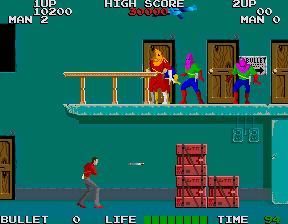 You can find a lot to like about Namco Museum Encore. The games Namco chose to include this time around are - despite the presence of King & Balloon - a solid, enjoyable group of games, even though very few people outside of Japan may have heard of Motos, Wonder Momo or Rompers. Since this was the last truly original NM disc, I wish Namco had included quite a few more games - namely Rolling Thunder 2, Dig Dug II, Phelios, Burning Force and Splatterhouse. Including those definitely would have made this disc the perfect way to end the series. Of course, a U.S. release would have been nice too...
You can find a lot to like about Namco Museum Encore. The games Namco chose to include this time around are - despite the presence of King & Balloon - a solid, enjoyable group of games, even though very few people outside of Japan may have heard of Motos, Wonder Momo or Rompers. Since this was the last truly original NM disc, I wish Namco had included quite a few more games - namely Rolling Thunder 2, Dig Dug II, Phelios, Burning Force and Splatterhouse. Including those definitely would have made this disc the perfect way to end the series. Of course, a U.S. release would have been nice too...
Visit the OPCFG for more import reviews!
